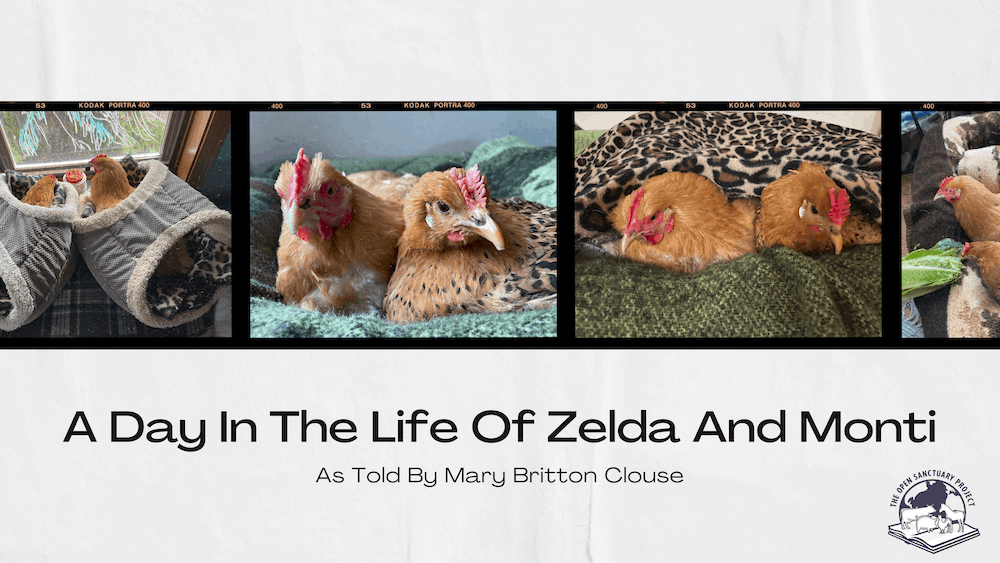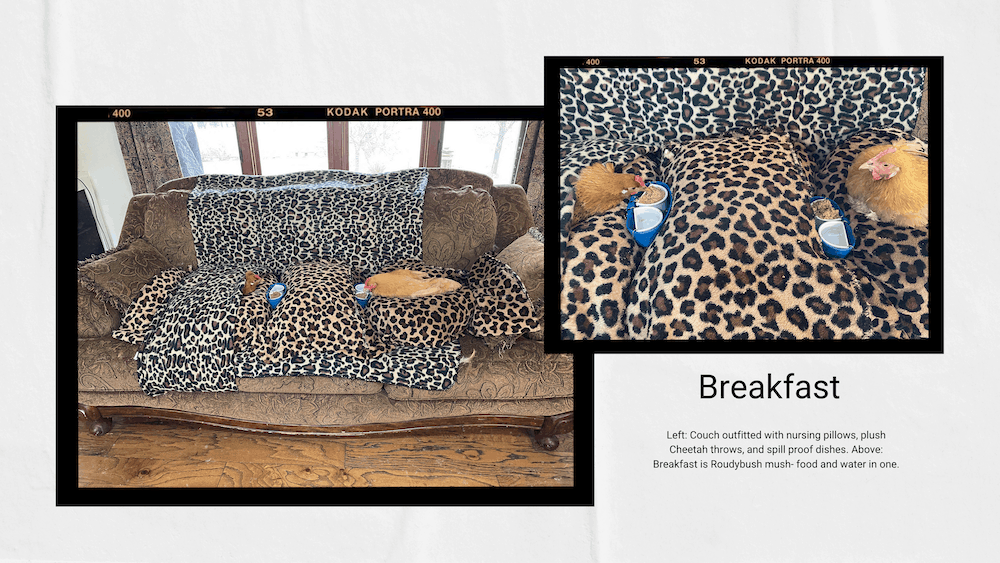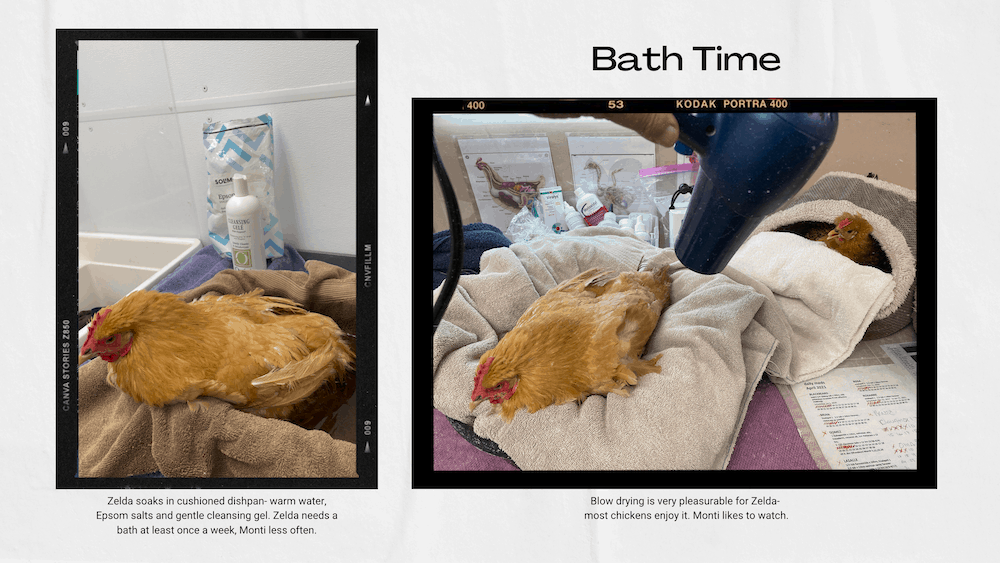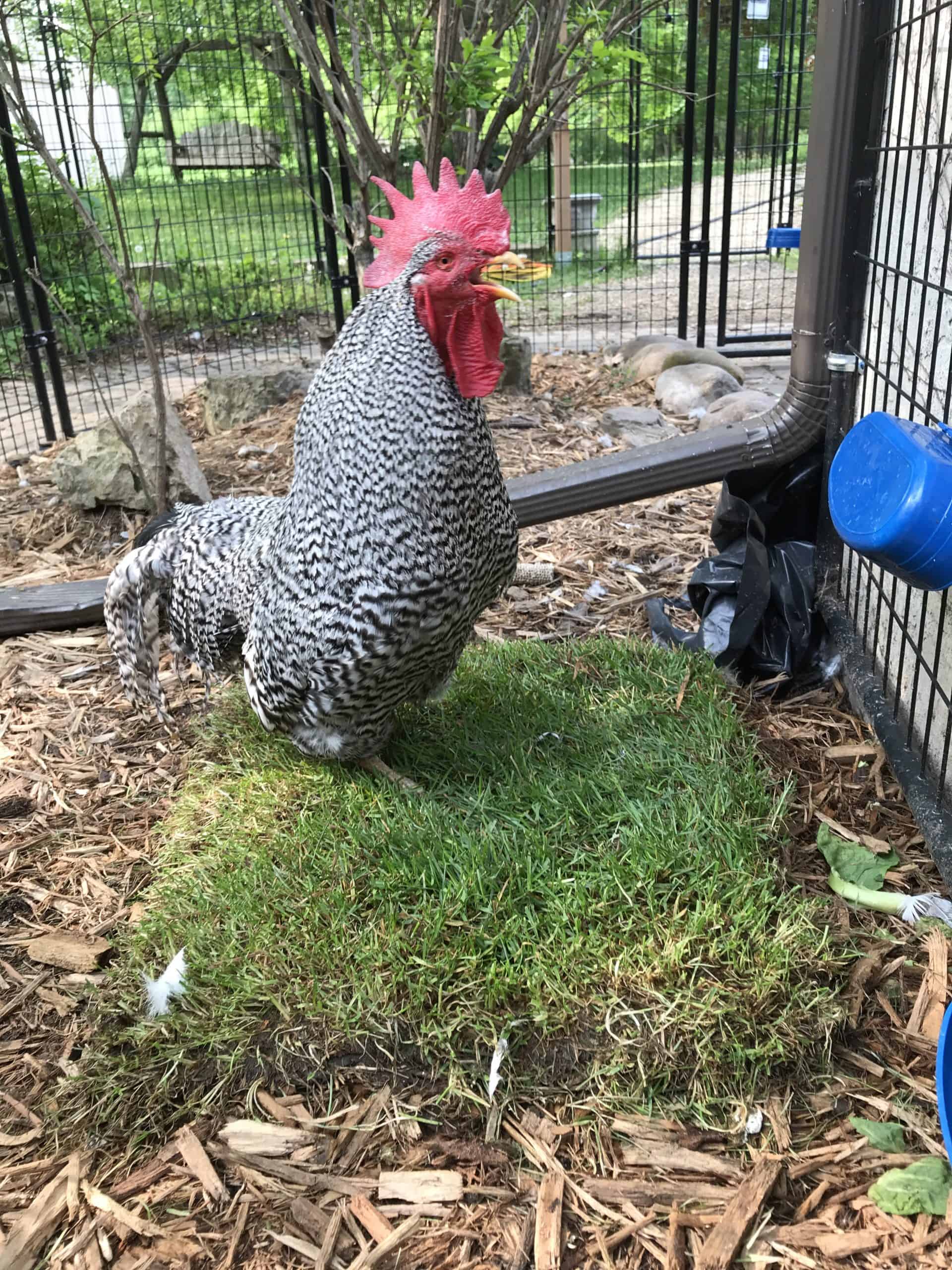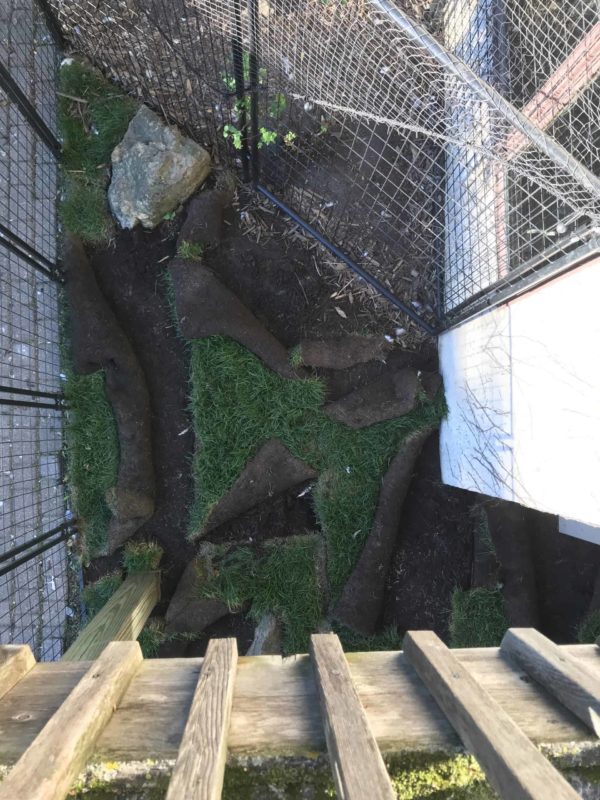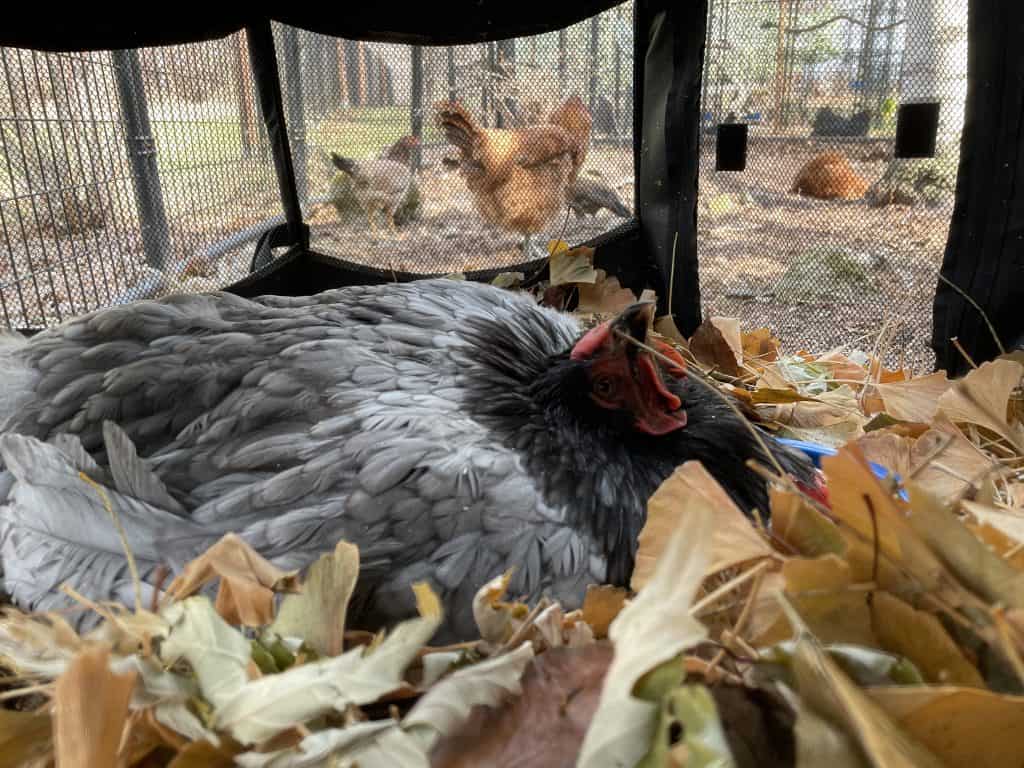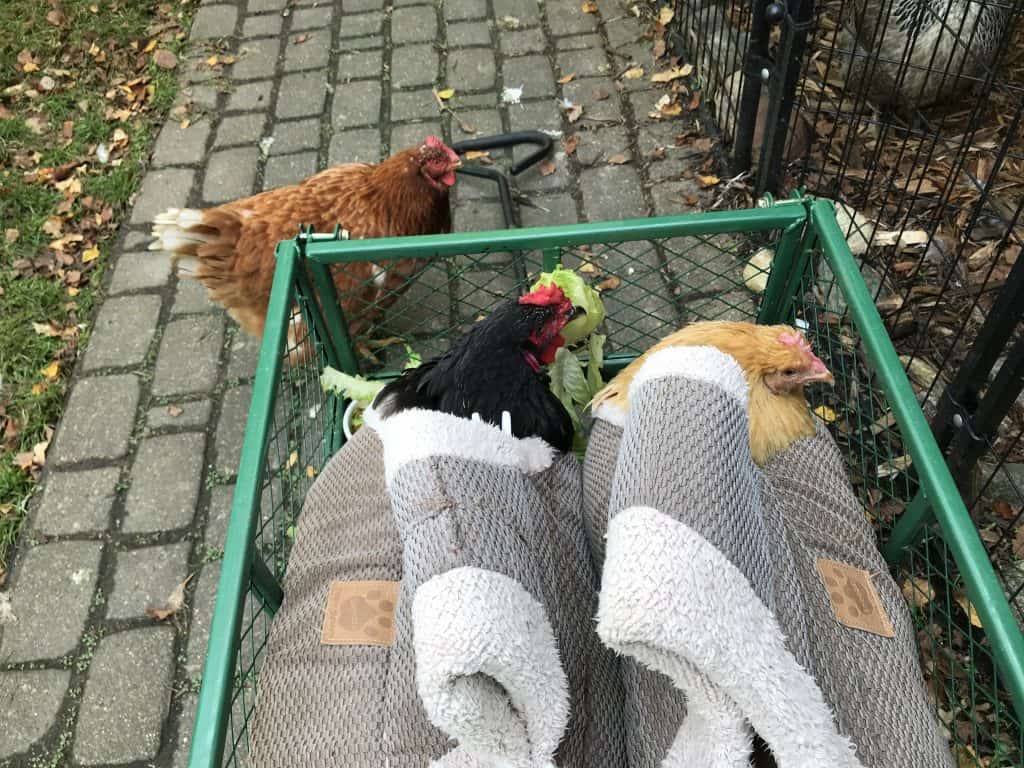
This Resource Is Part Of A Series!
If you haven’t already, be sure to start with Part One, which you can find here!
Physical Setup For Non-Ambulatory Residents
Offering safe physical accommodations is imperative for non-ambulatory residents, but setting up just one space in which they are forced to spend all of their time is not sufficient. At CRR, every day has a set routine of accommodations for morning, afternoon, and evening. Having access to a variety of surfaces throughout the day, both indoors and outdoors (when weather allows), is vital for physical comfort and mental stimulation. Non-ambulatory residents should have a variety of accommodations consisting of different substrates and offering ample cushion to prevent pressure sores or discomfort. These accommodations should also allow residents to spend time in different positions throughout the day. As Mary Britton Clouse, founderSomeone who starts an organization. A Founder may or may not also be the Executive Director of an organization. of CRR, puts it, “Respecting the birds’ dignity and self-determination/ autonomyThe ability for individuals to have access to free movement, appropriate food, and the ability to reasonably avoid situations they wish to avoid. is always the guiding principle in accommodations regardless of their physical abilities.”
Before talking about the specifics of how to create these accommodations and discussing other elements of supportive care, let’s meet Zelda and Monti, two of the many chickens who call CRR home, and take a peek at their daily routine-
Need A Transcript Of The Above Slideshow?
Click here to access a PDF containing the text and descriptions of the photos!
Now that we’ve seen some of the setups that work for Zelda and Monti, let’s talk more about how to create these spaces by looking at the different elements involved:
Bedding, Substrates, And Supportive Devices
Providing the right bedding and substrates is critical indoors and out. This is where the rubber meets the road, so to speak. For a non-ambulatory chicken, what’s under foot or body can mean the difference between utter discomfort and helplessness or the ability to have at least some control of movement and comfort. Providing variety throughout the day is key. The most appropriate types of bedding and substrates will vary by individual, as will the amount of time they spend on each, so be sure to create an individualized routine based on your residents’ needs and preferences (and don’t forget the importance of good notes so you can keep track of their preferences).
Bedding For Non-Ambulatory Residents
There are many ready-made high quality products designed to pamper dogs, cats, and human babies that adapt beautifully to the needs of chickens.
Qualities of good bedding, baskets, pillows, and cushions:
- Well-balanced and soundly constructed
- Thick but firm cushioning that allows some resistance for movement
- Soft, removable, washable fabric coverings
- Large enough for some repositioning but contoured like a chicken’s body- similar to a nest that would cradle and support the torso
CRR recommends using secondary throw blankets to line bedding, baskets, pillows, and cushions. This allows for quick and easy clean up; blankets are easily replaced with clean ones and laundered daily. Opt for blankets made of heavy, soft, plush fabrics which will prevent shifting and bunching while also providing comfort. When considering fabrics, choose one that would be comfortable to wear if you had a bad sunburn- this will ensure that it will be comfortable for your residents. Polyester plush/ fleece blankets are soft and inexpensive, making it easy to have multiple on-hand. As you can see from the photos, at CRR they like cheetah patterns and find this makes everything look calm, natural, intentional, and attractive.
Snoozzy baskets are a perfect size for most chicken residents for bedding and transport. Plush fleece throw keeps basket clean and adds extra cushioning. Zelda is ready to go anywhere by basket. Perry (congestive heart failure) supervises the flock from a feed pan padded with cushioning and fleece blanket. Serta dog bed with rolled rug to add 4th side provides thick but firm cushioning that allows some resistance for movement. Heavy fleece blanket cut in half, lays and stays flat. Other half of heavy fleece blanket rolled as a bolster. Monti and Zelda prefer to snuggle. They will be moved to the clean side at bedtime. Note cup with spoon at right to pick up feces. Shortly after Zelda’s arrival, one of CRR’s best volunteers spotted a nursing pillow in the store and recognized the potential immediately. Once covered with a fleece throw, a nursing pillow creates firm cushioning contoured similar to a nest to cradle and support a torso. Food dishes fit securely between pillows. Zelda’s comfort and food. Cavity of nursing pillow allows feces to drop away. Zazu and Detective Patty Lammers (both not disabled) sharing lunch with Skokie.
If needed, blankets can also be used to customize the setup and provide additional support to the individual. Soft plush/ fleece fabrics are also ideal for wraps, garments, slings, or anything else that will come in direct contact with feathers and skin because it is stretchable in several directions and does not unravel when cut. Wraps are sometimes needed for restraint for medication, safety, hyperactivity, or to soothe anxiety. If residents need garments such as cropA crop is a pouched enlargement of the esophagus of many birds that serves as a receptacle for food and for its preliminary maceration. bras, frocks, or jackets, CRR makes their own rather than using the products that are available online. They avoid fasteners like zippers, elastic bands, velcro, pins, and clips, which could be ingested or cause irritation or injury, opting instead to fasten materials by tucking or tying them. They also avoid stiff cloth that could cause irritation.
Lunaris gets additional support from an arrangement of soft blankets. Lunaris nestled in with layers of fleece. Bab’s frock kept her crooked legs from getting tangled in bedding. Hershey and Lunaris in fleece wraps and slings. Soft plush/ fleece fabrics are recommended for uses that will come in direct contact with feathers and skin. Opt for heavy, soft, materials which resist shifting and bunching while also providing comfort. Stretchable knitted fabrics are superior to woven for comfort and will not unravel when cut.
Something else CRR typically avoids are diapers. Not only have they found that most non-ambulatory residents don’t need them, they have also found that the typical design is not comfortable for them and keeps feces in close contact with the delicate skin around the vent until it’s changed. It’s actually much easier to scoop up feces and change out or refold a blanket than removing, emptying, and replacing a diaper. Not to mention it’s easier to see that clean up is necessary without a diaper in place to hide the mess. If an individual requires a diaper, CRR uses incontinence pads or adult diapers, which wick moisture away from the skin. These can be trimmed to fit between the legs with a slit to accommodate the tail. An ace bandage works well to secure it in place around the waist.
Substrates For Non-Ambulatory Residents
In addition to time in the setups described above, which keep residents a bit more contained, some individuals may benefit from being able to “exercise” daily in larger spaces that allow for more freedom of movement, but will require safe substrates to do so. CRR explains that healthy exercise will typically involve some short episodes of wriggling, flopping, and mild panting. Violent thrashing and heavy panting could risk major panic and injury such as dislocation. Be sure to monitor the individual’s activity and intervene if they risk injury or distress.
Qualities of good substrates:
- Flat
- Non-slip
- Cleanable
- Stable
- Non-abrasive
Substrates commonly used at CRR include rugs, leaves, sod, sand, and dirt.
Rugs
Heavy woven cotton throw rugs can be used both indoors and outdoors to provide a cushioned, but stable, surface to stand and lay on. Look for thick rag rugs that lay flat and do not bunch. When used in conjunction with a smooth surface, such as indoor flooring, you may need a rug with a rubber backing to prevent sliding. Outdoors, rugs can be used to cover wet ground or add cushion to hard-packed dirt areas. Rugs will need regular cleaning, so limit sizes to what your laundry can handle.



Top left: Rugs can be layered for cushioning. Bottom left: Skokie lost his feet to frostbite. The ends of his shanks were heavily calloused. He could walk and run surprisingly well on grass, but never left his rug when indoors. Right: Brian temporarily lost his coordination due to an idiopathic neurological episode. He was able to keep himself upright on rugs with rubber backing. He has since recovered.
Leaves
Dry non-toxic leaves are a great natural resource to bag and save each year. Like rugs, they can be used outdoors to cover wet ground or cushion hard-packed dirt areas. Indoors, they can be used in deep tubs, playpens, or other enclosures to provide cushion and act as an easily replaced litter. Leaves are lightweight and smell wonderful- in addition to being a safe substrate, they provide stimulation for scratching and pecking.

Grass
In outdoor spaces, cool, clean, soft grass is a wonderful substrate, especially in hot weather. Plus it’s a snack! To ensure safety, make sure existing grass, or any grass or sod you add to the space, has not been treated with any pesticides, herbicides, or fertilizers.
If your outdoor space does not have a grassy space for residents, but the climate allows for it, you can create one! While you can always start from scratch with grass seed, sod is another alternative. Not only does sod offer an instant grassy area, it can also be used much like an outdoor area rug and can simply be rolled out where needed. According to CRR, there is no need to prep or root it, but it should be hosed down thoroughly before placement. Sod is especially good for shady areas. When it wears out, it is easy and inexpensive to replace.
Cautions with sod:
- Some individuals will overindulge, especially on the dried blades at the edges, which can lead to crop impaction. Watch closely for signs of overindulgence and make adjustments as needed.
- Freshly laid sod attracts raccoons and other wildlife looking for grubs. In addition to ensuring resident safety, you may need to keep new sod covered overnight to protect it from being rearranged by wildlife.
If using grass seed, be sure to consider the best type of grass based on your climate and also the amount of sun the area will get, opting for quick-growing varieties whenever possible. To keep the area lush, CRR recommends overseeding regularly. While grass may seem like a substrate that can only be used in outdoor spaces, it is actually more versatile than that! Certain varieties such as rye, wheat, or oat grass can be grown in flats indoors during the winter, and much like leaves, can act as both a safe substrate and provide enriching stimulation. Grass and sod can be kept clean with a small landscape rake.
Skokie got new sod rugs when the old ones wore out. Blind Paloma found this sod rug all by herself with her feet. At CRR, Sod Day is a spring holiday every year, and the birds remember and revel in the event. The handiwork of a nighttime raccoon visitor. Zelda gets a taste of the outdoors during cold winter weather.
Dirt And Sand
Both dirt and sand can provide a soft, safe dustbathing material that is easy on the body and limbs. These substrates should be dry, at least two inches deep (the deeper, the more enjoyable), and should be free of debris.
Dirt should be free of pesticides, fertilizers, or herbicides. In some areas, the packed earth may be too hard or abrasive for a non-ambulatory resident. Depending on the composition, you may be able to break up the soil (CRR uses a mantis tiller for larger areas) and sift out any rocks or debris. If the existing ground won’t work or you are uncertain about its safety, bagged top soil is a good alternative. Be aware that airborne dirt leaves a film of soot and can affect air quality, so it’s not ideal for indoor use. Dirt can be kept clean with a fine-tine rake.
Play sand is safe and free from contaminants. Outdoors, you can dig out an easily accessible area and refill with sand. Because it is dust-free, sand can be a better option for indoor use than dirt, but it may not be a good option for hyperphagic residents who may try to eat it (such as large breedDomesticated animal breeds that have been selectively bred by humans to grow as large as possible, as quickly as possible, to the detriment of their health. chickens). Play sand can be kept clean with fine mesh strainer or fine-tine rake.
Slings, Therapy Chairs, And Carts
In some cases, individuals may benefit from time in a sling or therapy chair to help them stand for parts of the day, in addition to spending time in safe resting areas while not in the sling. This is not a setup typically used at CRR because they have found the other accommodations described throughout this resource work better for their residents and carry less risk of getting into a dangerous position. However, there may be situations in which standing while supported is recommended to encourage range of motion and muscle development for recovery. A sling can be made out of soft fabric with holes cut out for their legs and can then be held or secured at an appropriate height so the individual’s feet can touch the ground. Carts and therapy chairs can be purchased online or fashioned out of PVC.
When using a sling, therapy chair, or cart, make sure the individual has their food and water easily accessible, and closely monitor them to make sure they remain comfortable and safely positioned in the device. This setup may not be comfortable (or even physically possible) for everyone, may be difficult to keep clean, and carries the risk of individuals falling out or getting their legs tangled, so close observation is imperative.



When Skokie was unable to stand, his basket sling was a comfort for him short-term as CRR waited for a diagnosis- heart failure. Soft fleece blankets provided cushion to his residual limbs.
Enclosures For Non-Ambulatory Residents
When there are other animals (besides their trusted companions) in the environment, physically protected areas are needed indoors and out. Soft-sided playpens and modular dog pens are frequently used at CRR for this purpose.
Playpens
Soft-sided dog playpens (referred to as “yurts” at CRR) can be used both indoors and outdoors, so long as the weather cooperates and it’s not too windy. These are portable, lightweight, pop-up structures that fold up flat when not in use. The style used at CRR has a zippered top that can be adjusted or removed depending on what is needed. These playpens offer great visibility, so residents can see each other, yet occupants feel secure in them. This setup could be an especially good option for a newly immobile resident and might allow them to remain near their flockmates and continue to interact with them without the risk of being bullied. The soft fabric construction is a sufficient barrier for most individuals and is easy on feathers and beaks.
Playpens can be filled with different substrates, such as sand, loose dirt, or leaves, to give individuals the opportunity to experience and explore a variety of substrates. While this is a great option for non-ambulatory residents, it is also a great wintertime enrichment option for any chicken resident during times when they cannot safely go outside. Remember, while dirt can be used alone or with leaves, it creates quite a mess and may not be good for indoor use. Because of this, CRR replaced indoor dirt yurts with leaf yurts, which, while not quite as fun to say, still provide a stimulating option for residents! When used outdoors, the bottom of the playpen can even be removed to give residents access to the earth below.
Playpens offer great visibility, so residents can see each other, yet occupants feel secure in them. Here, Gomez can see Monti and Zelda from his yurt. Playpens can be filled with different substrates, such as sand, loose dirt, or leaves. Oma was diagnosed with a possible stroke but was able to remain with her people safely inside a playpen. Happily, the issue resolved two days later. Brian temporarily lost the ability to stand but was able to maintain his friendship with Juan as he recovered. Rooster relationships can be tricky if they need to be separated.
Modular Pens
Modular dog pens are another option for outdoor areas. These can be reconfigured in countless ways as needs change. At CRR, they offer a larger protected exercise area for vulnerable individuals and groups so residents with disabilities can enjoy being outside and among other residents while still being safe from the inevitable troublemakers. An additional barrier of soft vinyl poultry fencing around the lower portion of the pen prevents heads poking through and protects against pecking by said troublemakers.

At CRR, outdoor pens for residents with disabilities are furnished with an easily accessed area of deep play sand or loose soil and fresh sod so even residents with very limited mobility can safely move themselves about at their choosing.

Location
The ideal location for their setup, be it an enclosure or one of the bedding setups described above, depends on the individual, so take cues from their behavior. Some chickens thrive with interaction and the stimulation of being in an area with lots of human or flock activity and can suffer depression from lack of it. Others may be fearful or annoyed by activity and prefer a quiet place- watch for them trying to escape the situation by sticking their head as far as they can through fencing or hiding their head behind something, as this indicates they feel threatened or vulnerable. When considering location, keep in mind the importance of close monitoring, and choose a spot that allows for this.

Elevated Spaces
Almost always, chickens feel safest in a slightly elevated location. As seen in throughout this resource, individuals can be set up in baskets or beds set up on a couch or other elevated space. Additionally, utility carts and wagons are a means to set up beds and baskets that are up high, but mobile, and can be easily wheeled from place to place so the birds can see and safely interact and feel part of the flock. This is an especially good setup for time outdoors.
Outdoor Spaces
Obviously, non-ambulatory residents belong indoors in inclement or hazardously hot weather, but when the weather permits, they should have opportunities to enjoy the outdoors just like any other chicken resident. What this looks like will depend on the individual and your setup. Perhaps the individual can enjoy some time in the grass or can move themselves between a few different safe substrates such as grass, sand, and a soft rug. Alternatively, they might be able to enjoy the outdoors while set up in a padded basket or similar accommodation. Outdoor setups should be located in an area where caregivers are present or where they can monitor from a window and quickly respond if necessary. At CRR, their pen is located in an area with lots of activity and where they can see and interact with other residents while remaining safe.
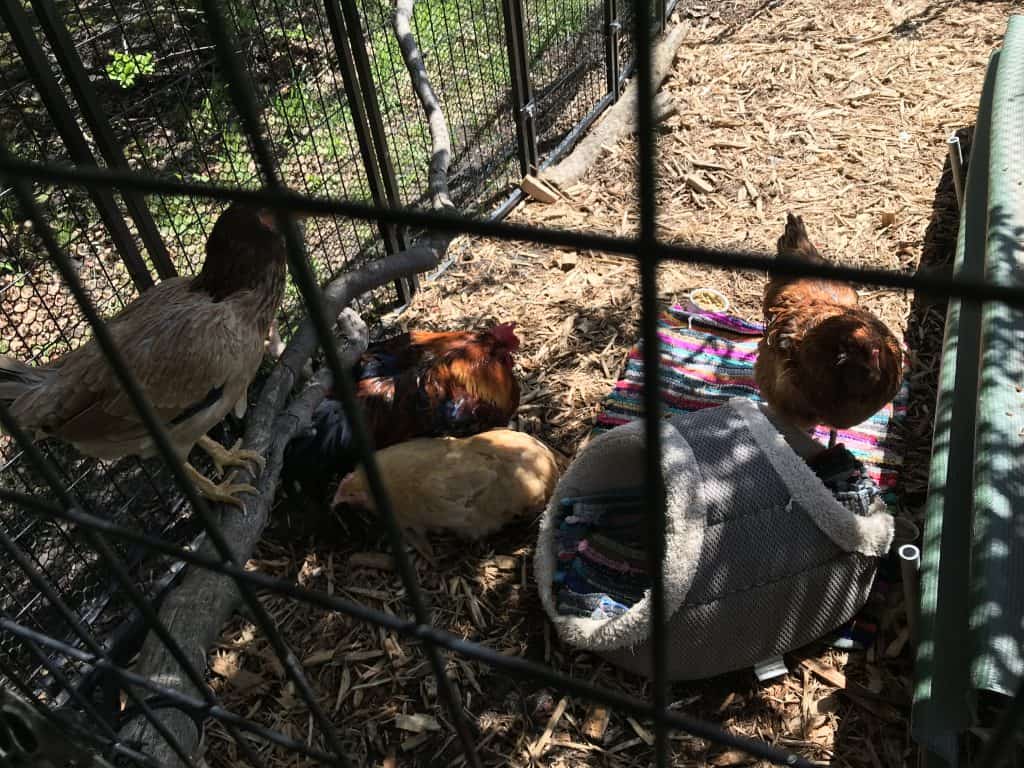
Outdoor areas should be well-drained, and provide sun as well as shade. CRR loves to use camouflage cloth which creates dappled shade, allows for airflow, and creates gentle movement in the breeze. Camouflage cloth can be repositioned throughout the day, as the position of the sun changes, to ensure shade continues to be available. It is a calm natural pattern and also provides visual cover from overhead. Chickens feel safest with some degree of overhead cover- feeling exposed out in the open is extremely stressful even for healthy birds. The addition of camouflage cloth can help residents feel safe, but be sure to position it high enough to prevent entanglement.

When residents are outdoors, keep a close eye for changing weather conditions, insect swarms, or uninvited guests of all species.
Cleaning
Good hygiene makes the difference between a happy existence and a miserable one. Animals will never choose to live in their own filth. Since non-ambulatory residents cannot control where they are (or have limited control over where they are), attention to a fastidious cleaning routine consisting of regular removal of feces, changing out bedding, and checking/ cleaning their butt is imperative. It may sound daunting but, as Mary Britton Clouse points out, “If what and when they eat is on a routine schedule, the output (poop!) in most cases follows predictably in about four hours.”
Bedding should be changed first thing in the morning (before coffee!). Most birds naturally “hold it” until they leave their sleeping quarters, so morning feces may be larger and more “fragrant”. After the morning bedding change, residents will need frequent checks throughout the day- typically every one to three hours- with feces removed and bedding changed as needed. CRR has found that a dedicated spoon is most useful to remove feces from a cushioned surface. After feces is removed, blankets can also be refolded to create a clean surface. Baby wipes and a comb work well for minor quick cleanups of residents.

The frequency at which residents need to be checked will depend on the individual and their current setup. For example, when they are indoors and are in setups that keep them more confined, hourly checks are often necessary in order to keep them clean. Loose dirt and sand coats feces, making sticking and smearing less likely, so when residents are spending time on these substrates, checking and cleaning areas every 2-3 hours may be sufficient so long as caregivers remain nearby and can respond to any issues that arise. When the weather is hot (and it gets really hot in Minnesota, where CRR is located) all residents, not just those who are non-ambulatory, are checked hourly to ensure their safety and comfort. Adjust schedules as needed to meet your residents’ needs.
Before laundering blankets or other bedding, scrape off excess feces. Regular laundry detergent is sufficient, but CRR recommends using the “hot” setting. They also have found that it’s helpful to use a washing machine cleaner product after every 30 loads. Bleach or other disinfectant are generally used only when there is concern about an infectious condition.
Check Out The Rest Of This Series!
To read Part Three, which focuses on feeding, enrichment, companionship, and hands-on care, click here!




